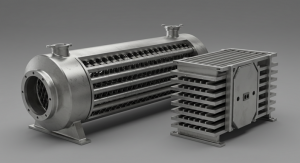Choosing the right type of heat exchanger is critical for achieving energy efficiency and operational reliability. Two of the most widely used designs are the tubular heat exchanger and the plate heat exchanger. While both serve the same basic purpose—transferring heat between fluids—their structure, performance, and ideal applications vary significantly.
A tubular heat exchanger consists of a series of tubes enclosed within a cylindrical shell. One fluid flows through the tubes, while another flows around them within the shell. This configuration offers excellent mechanical strength and is well-suited for high-pressure and high-temperature applications.
On the other hand, a plate heat exchanger uses thin, corrugated metal plates stacked together to form separate channels for fluids. It provides a high surface area for heat transfer in a compact design, making it ideal for applications with limited space and moderate operating conditions.
One of the major advantages of tubular heat exchangers is their robustness. They handle extreme temperatures and pressures better than plate designs, which makes them the preferred option in industries such as petrochemical, oil and gas, and power generation. The thick-walled tubes can resist corrosion, erosion, and thermal expansion over long periods.
In contrast, plate heat exchangers are known for their efficiency and compactness. Because of the large surface area per unit volume, they can achieve high heat transfer rates using a small footprint. This makes them popular in HVAC systems, food and beverage processing, and pharmaceutical industries.
Maintenance is another important consideration. Plate heat exchangers are relatively easy to clean by disassembling the plates and removing fouling. However, they are more prone to gasket failures, especially in high-temperature or aggressive chemical environments. In comparison, tubular exchangers are more difficult to clean, but their rugged design results in fewer maintenance issues over time.
When it comes to fluid compatibility, tubular exchangers are more versatile. They can handle fluids with high viscosity, solids, or fouling tendencies without major issues. Plate exchangers, while efficient, may clog more easily when dealing with dirty or viscous fluids.
From a cost perspective, plate heat exchangers usually have a lower initial cost, particularly for small to medium-scale operations. However, in long-term use and in demanding conditions, a tubular heat exchanger often provides better return on investment due to its durability and lower risk of failure.
Installation space can also be a deciding factor. Plate heat exchangers are compact and lightweight, requiring less room for setup. Tubular exchangers, although larger, are better suited to environments where system longevity and reliability outweigh space constraints.
In terms of thermal performance, both types can deliver excellent results when properly designed. However, if the application involves phase changes like condensation or evaporation under pressure, tubular heat exchangers offer more stability and better control.
Many industries employ both types of exchangers depending on the specific process requirements. For instance, a food processing plant might use plate exchangers for pasteurization and tubular exchangers for handling slurry or high-temperature sterilization.
Selecting between a tubular and plate heat exchanger should be based on process conditions such as temperature, pressure, fouling tendency, available space, and maintenance capability. Consulting with experienced engineers ensures the right configuration and materials are chosen for long-term reliability.
Overall, while plate heat exchangers offer high efficiency in space-saving designs, the tubular heat exchanger remains the top choice for heavy-duty industrial operations where reliability, pressure resistance, and versatility are essential.
FAQs About Tubular vs. Plate Heat Exchangers
Which is better for high-pressure applications?
Tubular heat exchangers are better suited for high-pressure systems due to their strong tube construction and resistance to mechanical stress.
Are plate heat exchangers easier to clean?
Yes, plate heat exchangers are generally easier to clean due to their modular design, but they may require more frequent maintenance due to gasket wear.
Can tubular heat exchangers handle dirty or fouling fluids?
Absolutely. Tubular designs are more tolerant of fouling, sludge, and viscous fluids, making them ideal for challenging industrial environments.
Which exchanger offers better heat transfer efficiency?
Plate heat exchangers typically offer higher efficiency per unit area, but tubular exchangers perform better under extreme conditions.
What is the typical lifespan of a tubular heat exchanger?
With proper maintenance, tubular heat exchangers can last 20 years or more, even in harsh industrial settings.
